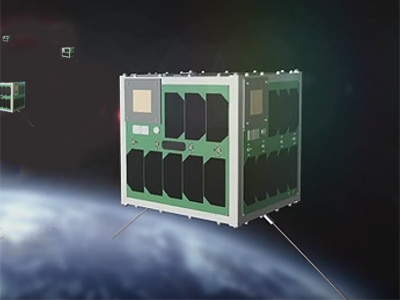Thank you very much for visiting Gunter's Space Page. I hope that this site is useful and informative for you.
If you appreciate the information provided on this site, please consider supporting my work by making a simple and secure donation via PayPal. Please help to run the website and keep everything free of charge. Thank you very much.
S-Net A, B, C, D (Tubsat 13, 14, 15, 16)

S-Net [TU Berlin]
S-Net is a nanosatellite project of the Technical University of Berlin to investigate and demonstrate the inter-satellite communication technology within a distributed an autonomously operating nanosatellite network.
As space born systems have become an essential element in facing global challenges such as climate change, disaster management and maritime systems monitoring, rapid response and low cost systems are in high demand.
A key technology to increase the operational efficiency of distributed satellite systems via formations or even autonomous swarms is the miniaturizing of intersatellite communication technology. TU Berlin developed an S band transceiver (SLink) with 100 kbps crosslink and 1 Mbps downlink capability suitable for accommodation in nanosatellites.
Currently TU Berlin is developing a mission of four nanosatellites to verify the SLink payload and demonstrate intersatellite communication on a sophisticated level. An increasing numbers of communication entities participating in the network relates to a larger test bed for algorithm and verification. However for a nanosatellite based demonstration mission, four satellites present the best cost-benefit-ratio. Four entities enable six independent communication links while three satellites only make three links possible. Furthermore a multi-hop communication can only be realized with a number of at least four nodes.
A fifth satellite was built as a flight spare, but will be reworked for the SALSAT project.
| Nation: | Germany |
|---|---|
| Type / Application: | Technology |
| Operator: | TU Berlin |
| Contractors: | TU Berlin |
| Equipment: | SLink payload |
| Configuration: | TUBiX10 bus |
| Propulsion: | None |
| Power: | Solar cells, batteries |
| Lifetime: | 1 year |
| Mass: | 8 kg |
| Orbit: | 571 km × 588 km, 97.73° |
| Satellite | COSPAR | Date | LS | Launch Vehicle | Remarks | |
|---|---|---|---|---|---|---|
| S-Net A (Tubsat 13) | 2018-014J | 01.02.2018 | Vo LC-1S | Soyuz-2-1a Fregat | with Kanopus-V 3, Kanopus-V 4, S-Net B, S-Net C, S-Net D, Lemur-2 74, ..., 77, D-Star One v.1.1 | |
| S-Net B (Tubsat 14) | 2018-014H | 01.02.2018 | Vo LC-1S | Soyuz-2-1a Fregat | with Kanopus-V 3, Kanopus-V 4, S-Net A, S-Net C, S-Net D, Lemur-2 74, ..., 77, D-Star One v.1.1 | |
| S-Net C (Tubsat 15) | 2018-014K | 01.02.2018 | Vo LC-1S | Soyuz-2-1a Fregat | with Kanopus-V 3, Kanopus-V 4, S-Net A, S-Net B, S-Net D, Lemur-2 74, ..., 77, D-Star One v.1.1 | |
| S-Net D (Tubsat 16) | 2018-014G | 01.02.2018 | Vo LC-1S | Soyuz-2-1a Fregat | with Kanopus-V 3, Kanopus-V 4, S-Net A, S-Net B, S-Net C, Lemur-2 74, ..., 77, D-Star One v.1.1 | |
| S-Net Spare | - | cancelled | modified as SALSAT |
References:
- TU Berlin: S-Net
- Tubsat 1 (Tubsat A)
- Tubsat 2 (Tubsat B)
- Tubsat 3 (Tubsat N)
- Tubsat 4 (Tubsat N1)
- Tubsat 5 (DLR-Tubsat)
- Tubsat 6 (Maroc-Tubsat)
- Tubsat 7 (LAPAN-Tubsat)
- Tubsat 8, 9, 10, 11, 17 (BeeSat 1, 2, 3, 4, 9)
- Tubsat 12 (TechnoSat)
- Tubsat 13, 14, 15, 16 (S-Net A, B, C, D)
- Tubsat 18, 19, 20, 21, 23, 24, 25, 26 (BeeSat 5, 6, 7, 8, 10, 11, 12, 13)
- Tubsat 22 (SALSAT)
- Tubsat 27 (TUBIN)
- Tubsat 28, 29 (NanoFF A, B)
- CyBEEsat
